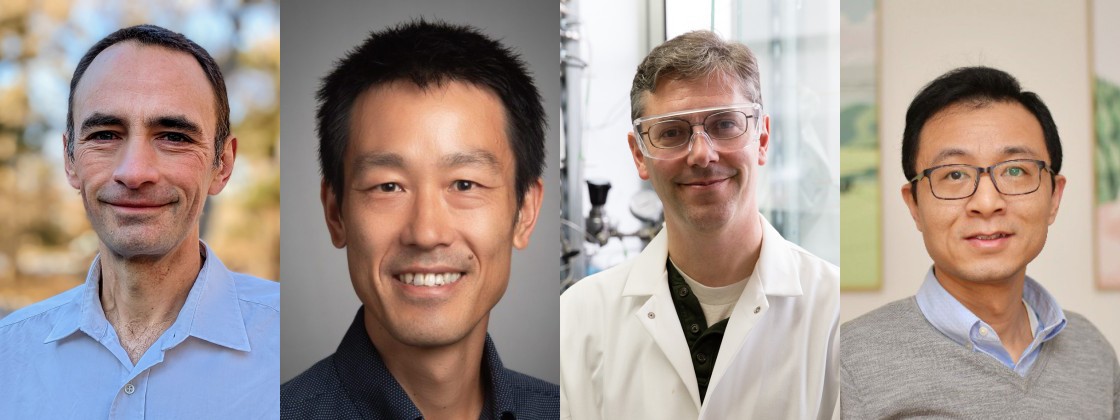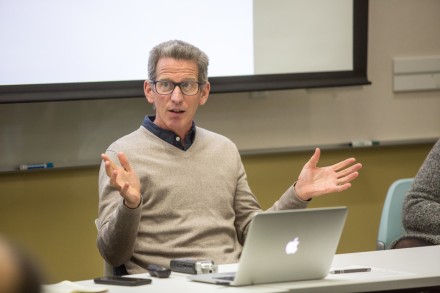Plastic recycling, renewable chemicals, carbon-negative concrete among key innovations

Computer-assisted technology for recycling plastics, a technique for producing a valuable chemical from agricultural waste, and genetic mutations that can turn trees into carbon-sucking chemical factories are among the innovations by Wisconsin Energy Institute investigators that address critical environmental concerns while driving new business ventures.
The Wisconsin Alumni Research Foundation (WARF), an organization that supports UW–Madison research and helps commercialize discoveries, recently profiled several of these scientists and their innovations.
Reducing the need for synthetic fertilizer
Jean-Michel Ane, UW-Madison professor of bacteriology, wants to bring scientific rigor and certainty to the field of nitrogen fixation, which he says has been tainted by hype and exaggeration.
He’s working on several approaches using altered microbes and plants to reduce reliance on synthetic nitrogen-containing fertilizers, which sustain crops for half the world’s population. Because their use has led to downstream environmental consequences, efforts have been made to limit these impacts over the past century.
“Even right now, you have several companies selling bacteria that supposedly give nitrogen to plants, and they have little solid data to support their claim,” he said. “There is a lot of snake oil in my field. And that hurts really bad, it hurts the trust that growers but also sometimes even scientists have for the benefits that we can get from these approaches.”
In hopes of restoring trust in the field while also addressing environmental concerns, Ane has created modified forms of bacteria that provide much more nitrogen to their host plants in exchange for sugars from photosynthesis.
Through genetic manipulation, Ane has largely removed the microbes’ “brakes” that limit this process of nitrogen fixation, forcing them to absorb much more than their unaltered counterparts. That means less artificial fertilizers are needed. But because this reduces the microbes’ ability to persist in the environment, the trick has been to find a balance between these changes and survivability.
While development continues on the microbe side, Ane is also pursuing ways to alter the plants themselves to be better hosts for the nitrogen-fixing bacteria. That includes taking structures that naturally occur in some tropical plants and causing them to be expressed in others that are grown in this part of the world.
Plant Power
UW-Madison’s Maeda lab has identified a plant mutation that could be key to disrupting fossil fuel-reliant chemical synthesis industries.
Hiroshi Maeda, a botany professor at the university, says there’s a big opportunity to use plants as a chemical production platform, replacing petroleum-based production of aromatic compounds. These chemicals are widely used in consumer products, ranging from plastics to food and medicines, Maeda said in an interview.
“Many of these aromatic chemicals are currently extracted from fossil fuels, and that leads to their quite substantial contribution to global warming,” he said.
His work in this area began about 13 years ago when he first came to UW-Madison, exploring metabolic pathways within plants that convert sugars and other carbohydrates into these aromatic chemicals. Most approaches failed. But about five years ago, after inserting various mutations into test plants, the team found one that “accumulated really high levels” of the target compounds.
Since identifying the mutation responsible for this “drastic change” in chemical metabolism, his team has been testing if it can achieve the same result in other plants. With support from the WARF Accelerator program, they successfully demonstrated the same effect in soybean plants and are conducting further analysis.
As an added benefit, Maeda notes the mutation could result in the soybeans being more nutritious due to having higher levels of aromatic chemicals. And importantly, the altered plants that are producing more of these compounds are also capturing up to 30% more carbon dioxide to support that process.
“That’s another trait that we are interested in … With a single mutation, we may be able to achieve two exciting results,” he said. “One is to make more useful aromatic chemicals. But at the same time, suck up more CO2 from the air, reducing CO2 concentration in the atmosphere.”
Turning carbon dioxide into cement alternative
A UW-Madison spinoff and WARF Ventures portfolio startup called Alithic is raising funds as company leaders gear up to launch a pilot plant in the coming years.

The business is based on research from Bu Wang, an associate professor of civil and environmental engineering who leads the university’s Sustainable Materials Innovation Lab. He developed a way to use coal and steel waste to create a carbonated material that can be used in cement production, while also capturing carbon dioxide directly from the air as part of that process.
The company’s carbon capture to carbon-negative cement materials technology has been tested through a WARF Accelerator-backed project on campus. It has the potential to enable more efficient and less expensive CO2 removal while helping to offset the global cement industry’s considerable carbon footprint.
Now, under the direction of CEO Quentin Phillippe, Alithic is adding domain experts to its team and connecting with investors to fuel the next phase of development.
Greg Keenan, senior director of WARF Ventures and WARF Accelerator, says the team is “well on their way.”
“The company is successfully raising institutional investment, which is huge,” he said. “When you have a technology like this that’s able to raise institutional capital spinning right off campus, it’s remarkable and we love to see that.”
Investment funds will be used in designing the company’s pilot plant, which WARF expects will come online in 2025 or 2026. The company is already working with an engineering firm on that effort and identifying potential locations for the plant. Meanwhile, conversations are underway with potential customers in the cement industry as well as feedstock suppliers.
Chemical recycling for plastics
UW-Madison Professor George Huber, a former investigator with WEI and the Great Lakes Bioenergy Research Center, aims to fundamentally change the way certain plastics are recycled in the midst of what he calls the “plastic era.”
“It has the chance to be a revolutionary process,” Huber said in an interview. “We use plastics for everything, but we really haven’t thought about the end-of-life use of most plastic material. While the main end-of-life use really is landfills in Wisconsin … plastics really are a resource that we can use to remake new materials.”

Most plastic products also include other additives such as dyes and films, and traditional mechanical recycling can struggle to separate these materials, Huber said. Even getting clean plastic bottles back from consumers can be a challenge, as they’re often contaminated with residues from food and other sources.
As an alternative, Huber has been working since 2019 on technology developed with WEI investigator Reid Van Lehn called STRAP, which stands for solvent-targeted recovery and precipitation, and received support from WARF Accelerator to fund the initial scale up of the process. The method can break down mixed plastic waste to recover high-quality pure plastic resins for use in other products. That gives it a “big advantage” over the standard method, he said, as it can even remove a common oxygen barrier coating used to keep food and beverages fresh.
In partnership with a company in Neenah called Amcor, Huber’s team has been honing this process to improve the clarity of its plastic end-product, which he says is already better than any comparable material on the market.
Pyran
Huber also helped found a startup company that's turning agricultural waste into a valuable chemical at a lower cost than using fossil fuel feedstocks.
Pyran uses one of Huber's innovations to convert furfural into 1,5-pentanediol, a valuable material that can replace petroleum-based 1,6-hexanediol in paints, nail polish, coatings, adhesives and certain plastics.
Furfural is made from inedible leftover plant crop materials like corn cobs, with about 600,000 tons of capacity available worldwide. By contrast, 1-5-PDO is produced in small amounts as a byproduct of the oil industry, but that process is relatively difficult, Huber explains.
“But we can make it from furfural very easily, we have a very efficient process to make it,” said Huber, who acts as a board advisor for the business.
Pyran has made dozens of barrels of 1-5-PDO already, and is working toward building a per year production plant as it conducts permitting and engineering planning and considers possible locations.
Read these and other profiles on the WARF website.
